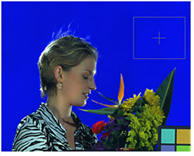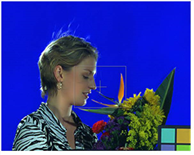Search is based on keyword.
Ex: "Procedures"
Do not search with natural language
Ex: "How do I write a new procedure?"
Analyzing and Removing Noise
| 1. | In the Denoise controls, set Source to Film or Digital depending on the type of footage you’re using. Digital is the default setting and it works fine in most cases even if the footage is in a film format. |
| 2. | In general, you can also leave Noise Model set to Modulated. However, you may want to try Constant if you’re working on either: |
• film footage with lots of detail but not too much noise in dark regions, or
• digital footage with lots of detail but not too much noise in light regions.
| 3. | In the Viewer, scrub to a frame with a suitable analysis region. This should be a flat area free from image detail, so no textures, edges, or shadows. If this is not the case, you may get poor results, as the algorithm thinks the image detail is noise and removes it. |
| 4. | You can enable Temporal Processing to use more than one frame to denoise the analysis frame. Denoise blends frames either side of the analysis frame to improve the result. The number of frames used either side of the current frame is determined by the Frames To Blend control. |
Note: Temporal Processing requires the motion, forward, and backward channels from the Motion input. You can't enable Temporal Processing unless the Motion input is connected.
You can increase the Frame Blending value to force Denoise to blend more regions of the frame, but higher values can lose image detail.
| 5. | Position and resize the analysis box to cover the analysis region. Note that the minimum size for the analysis region is 80x80 pixels. If the analysis region is too small, Denoise cannot analyze the footage or remove any noise. |
|
|
|
| A good analysis region. | A poor analysis region. |
The analysis area selection automatically updates not only the Analysis Region parameter in the Noise Analysis group, but also the frame from which the sample is taken (Analysis Frame). By default, whenever the analysis box is altered, the internal analysis of the noise in that region reoccurs.
| 6. | Connect a Viewer to the Denoise node. |
The output should now show the denoised frame.
| 7. | Proceed to Reviewing the Results. |
Tip: By default, Denoise starts analyzing the noise in your input footage when you move the analysis box. If you scrub to a new frame, don't move the analysis box, and want to reanalyze the noise from the new frame, you can force analysis by clicking the Analyze Noise button in the Noise Analysis parameter group.
If you’d like to disable analysis, you can check Lock Noise Analysis.
Tip: You can export the analysis profile in an external file. Note that if you’ve set Profile to Constant, only the controls that affect the analysis are saved in this file. By contrast, if you’ve set Profile to Automatic, both the analysis profile and the automatically calculated noise profile are exported.
To export the profile, use the Analysis file control under Noise Analysis to set the name and location of the file. The file extension doesn’t really matter here - for example .txt is fine. Once you have named the profile, click the Export button to export it.
To import the same profile later, use Analysis File again to navigate to it and click Import. This disables any controls that are read from the profile. To re-enable them, you can uncheck Lock Noise Analysis.
Sorry you didn't find this helpful
Why wasn't this helpful? (check all that apply)
Thanks for taking time to give us feedback.

